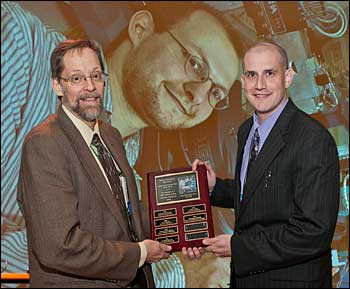2012 Baumert Award: Christopher J. Patridge
June 2, 2012

Erik Johnson (left), Photon Sciences Deputy Associate Laboratory Director for Programs, congratulates Baumert Award winner Christopher Patridge.
Christopher J. Patridge, a National Research Council Post-Doctoral Fellow at the Naval Research Laboratory, is this year’s recipient of the Julian Baumert Ph.D. Thesis Award. Patridge was selected for his outstanding work in solid-state chemistry at NSLS beamlines U7A and X23A2.
The Baumert Award is given to a researcher who has recently conducted a thesis project that included measurements at NSLS. It was established in memory of Julian David Baumert, a young Brookhaven physicist who was working on x-ray studies of soft-matter interfaces at NSLS before he died in June 2006.
Patridge holds a B.A. in Chemistry (2002) from the University of Buffalo, SUNY, and an M.S. in Forensic Science (2006) from the John Jay College of Criminal Justice, CUNY.
He completed his doctoral dissertation under professors Sarbajit Banerjee and Esther S. Takeuchi in the Department of Chemistry at the U. of Buffalo, earning a Ph.D. in Chemistry (2011).
Wrote Professor Banerjee about Patridge, “[H]e is an uncommonly gifted young scientist with a keen eye for the unexpected and a rare gift of being able to establish mastery over new experimental and theoretical methods in a very short period of time.”
Patridge’s doctoral thesis focused primarily on the electronic structure peculiarities that emerge when metal doped vanadium oxide MxV1-xO2 or metal-intercalated vanadium oxide bronzes MxV2O5 are scaled to reduced dimensions. Using a combination of V K-edge x-ray absorption near edge structure (XANES) and extended x-ray absorption fine structure (EXAFS) at the V K-edge with soft x-ray measurements at vanadium L-, oxygen K-, and potassium L-edges, he was able to demonstrate that tungsten and molybdenum dopants in VO2 essentially serve as “Trojan Horses” nucleating high-symmetry domains akin to the high-temperature metallic phase. This work establishes a rational basis for tuning the dramatic metal-insulator transitions of VO2 with transition metal dopants.
His XANES and EXAFS work also established the mechanistic basis for colossal phase transitions observed in MxV2O5 bronzes when M = K or Cu. The XAS data provided clear evidence for charge disproportionation and charge ordering on the mixed-valence vanadium-centered quasi-1D frameworks.
Patridge’s exquisitely detailed studies of local structure have answered some longstanding questions about the mechanistic basis for metal-insulator transitions in vanadium oxides and further elucidated the mechanistic basis for lithiation of common cathode materials right down to the level of identifying specific orbitals on metal centers involved in electrochemical processes.
His research has been published in leading journals such as Nano Letters, Chemical Communications, Journal of Physical Chemistry C, Nature Communications, and Journal of Physical Chemistry Letters.
Patridge received the Baumert award and a $600 honorarium on May 22, 2012, at the 2012 Joint NSLS and CFN Users’ Meeting, where he gave a 15-minute presentation on his thesis work. His name will be engraved on a plaque in NSLS.
2012-3177 | INT/EXT | Newsroom









